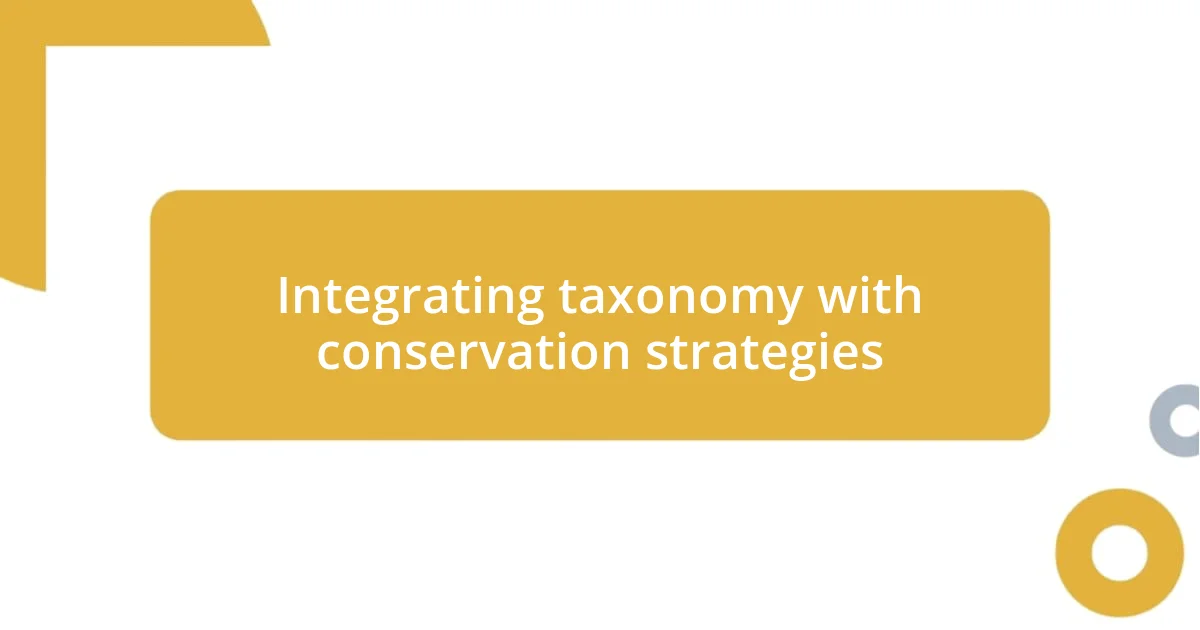Key takeaways:
- Taxonomy is essential in conservation, helping to identify, categorize, and prioritize species vital for ecosystem health.
- Biodiversity supports ecosystem functionality and resilience, offering services like clean air, food security, and climate regulation.
- Integrating taxonomy into conservation strategies enhances the effectiveness of efforts and promotes community engagement in protecting local biodiversity.

Understanding taxonomy in conservation
Taxonomy is the foundation of conservation because it helps us identify and categorize the diverse species on our planet. I remember visiting a biodiversity hotspot and being awestruck by the vast array of plants and animals. It hit me then—how can we protect what we don’t even know exists?
Understanding the relationships between species is crucial to conserving ecosystems. For instance, I’ve often thought about keystone species—those that play a critical role in maintaining the structure of an ecological community. When I learned how sea otters keep kelp forests healthy, I couldn’t help but wonder: if we lose such a pivotal species, what else might disappear with it?
Taxonomy also guides conservation priorities. When faced with limited resources, I find myself asking, “Which species should we focus on?” By understanding taxonomic relationships, we can prioritize efforts based on a species’ ecological importance or threat level, ensuring that our conservation strategies are both strategic and effective.

Importance of biodiversity in ecosystems
Biodiversity is the backbone of healthy ecosystems, providing a wealth of services that sustain life. I recall a moment in a tropical rainforest, surrounded by the symphony of sounds from countless organisms. It made me realize just how interconnected every species is—each playing its unique role in maintaining ecological balance. This intricate web of life ensures everything from clean air to pollination and contributes to the resilience of ecosystems against environmental changes.
- Biodiversity enhances ecosystem productivity, with diverse species contributing to higher yields.
- It promotes resilience, allowing ecosystems to recover more effectively from disturbances like climate change.
- Rich species diversity increases the availability of genes that might help with disease resistance and adaptation.
- Healthy ecosystems support a variety of services, including food security, clean water, and climate regulation.
- Biodiversity has intrinsic value, offering beauty and inspiration that enrich our lives and culture.

Methods for assessing species diversity
Assessing species diversity is an essential task that involves several methods, each with its strengths. One effective technique I’ve encountered is field surveys. During my early days as a wildlife enthusiast, I spent countless hours wandering through forests and wetlands, counting species. The thrill of spotting a rare bird or an elusive mammal reinforced my belief in the importance of meticulous biodiversity assessments. Field surveys provide invaluable data on species presence, distribution, and abundance, helping us understand which species are thriving and which ones are at risk.
Another method I find fascinating is DNA barcoding. This technique allows us to identify species based on genetic material, which is especially useful for cryptic or difficult-to-identify organisms. I remember a particular project where we applied DNA barcoding to a collection of butterflies. The results were astounding—we discovered several species previously unknown to be in that region! The excitement of scientific discovery through such technology is truly inspiring, illustrating how far we’ve come in understanding the richness of life.
Lastly, remote sensing technology has revolutionized how we assess species diversity over large areas. With the help of satellites, I once tracked changes in habitat quality in a coastal region I hold dear. The ability to monitor ecosystems from above not only enhances our understanding of biological diversity but also helps gauge the impact of human activities. Each of these methods contributes uniquely to our overall comprehension of biodiversity, enriching both my personal experiences and the wider conservation efforts.
| Method | Description |
|---|---|
| Field Surveys | Involve direct observation and counting of species in their natural habitats. |
| DNA Barcoding | Uses genetic material to identify and categorize species, especially those that are hard to distinguish visually. |
| Remote Sensing | Employs satellite technology to monitor and assess biodiversity over large geographical areas. |

Integrating taxonomy with conservation strategies
Integrating taxonomy into conservation strategies is crucial for targeting efforts effectively. I remember attending a conservation workshop where a seasoned biologist shared an eye-opening insight: knowing the precise taxonomy of a species helps prioritize which ones need urgent protection. Have you ever thought about how a detailed understanding of species’ relationships can shape our conservation priorities? It’s fascinating to see how taxonomy allows us to identify key species that, if preserved, can support the broader ecosystem’s health.
Moreover, precise taxonomic classifications can prevent costly mistakes in conservation programs. For example, in a project I was involved with, we mistakenly focused our resources on a more common species, overlooking a closely related but endangered one. The realization that a small taxonomic distinction could have monumental consequences spoke volumes about the need for accuracy. This experience reinforced my commitment to including thorough taxonomic research in any conservation strategy I undertake.
Finally, engaging local communities in taxonomy can strengthen conservation initiatives. During a field project, I found that educating locals about their region’s unique species fostered a deeper sense of stewardship. It was heartwarming to see people take pride in their local biodiversity, understanding how their actions could impact the delicate balance of nature. Integrating taxonomy not only informs conservation strategies but also cultivates a shared responsibility to protect our planet’s incredible diversity.














